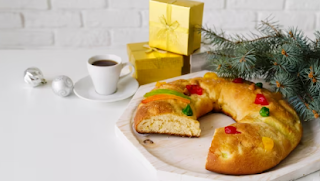El Roscón de Reyes - The king of the Christmas desserts
If there is something that Spanish people love about Christmas - apart from spending time with family and friends - is eating. By the 5th of January we can barely eat more food or sweets but we need to leave room in our stomachs for the last dessert of the holidays: the Roscón de Reyes.
On top of the traditional Roscón you can find almonds, sugar and candied fruit (fruta confitada) of different colours: red, green and orange. These resemble the jewels of the crowns that the Kings wear on their heads. Did you know that most people take off the fruit and do not even eat them?
What is the origin of the Roscón de Reyes?
Although these days the Roscón is associated with Christmas and the Three Kings, the origin takes us back to the 2nd century BC. Back then, people celebrated Las Saturnales, an event that took place during the winter solstice. People celebrated the beginning of longer days and they ate a cake. Over time, this cake evolved to what we eat now.
A century later, they started to introduce a bean (el haba) as a symbol of prosperity. This way, it was thought that the person who would find the bean would enjoy good luck for the whole year and was named king of the group. This pagan tradition would slowly disappear and we had to wait a few centuries for this to be considered a religious tradition.
The current tradition
Nowadays, the tradition of the Roscón has changed a bit. Bakers put two things inside: a figurine and a bean. The person who finds the figurine gets a paper-like crown that comes with the dessert and is named king/queen. On the other hand, if the bean comes out, the unlucky person has to pay for either that Roscón or next years'. But let's be honest: who will rememeber that after a year?
The Roscón de Reyes has evolved a lot during the last few years, in its elaboration as well as in the prizes you can find inside. Currently, it is very common to find healthier options made with Matcha tea o sesame seeds; for those with a sweet tooth, there are some with pink glaze on top or Kinder-style Roscones. They look delicious!
Matcha tea Roscón. Credits: 20minutos.com
Pink panther Roscón. Credits: Hule y Mantel
When it comes to prizes, some establishments are very creative in order to attract customers. In a bakery located in Castilla-La Mancha, they included gift vouchers to be used in local shops and in a pizza restaurant in Tomelloso (Ciudad Real) they hid gold lingots worth three hundred euros! You can see the piece of news here.
Can it be made at home?
As you already noticed, the Roscón is very popular in Spain. However, it is a type of dessert that only very very few people try to bake at home. This is because of the slow and careful elaboration that takes to make it right. Just a slight error could ruin up to five hours of work in the kitchen!
During the 2020-2021 Christmas, our teacher Bea spent the holidays in Ireland due to the COVID-19 restrictions, so she decided to bake a Roscón. 'I couldn't get all the exact ingredients but I could get the necessary ones to make a basic Roscón. What started as a relaxing day off in the kitchen turned out to be a disaster as I struggle with the dough. When I thought that the roscón was fully cooked, I opened the door to check and it "deflated". How upsetting! Despite that, it was delicious and was a success among my Irish friends', she said.
What about you? Have you ever tried the Roscón? Do you have a favourite one or which would you like to try? Tell us in the comments 😊








Thanks for sharing such informative things.
ReplyDeleteReally Nice! Very useful information in this blog! Thanks for sharing with us!
ReplyDeleteYour article is very nice & informative, thanks for the sharing with us.
ReplyDelete